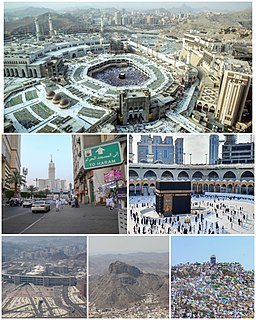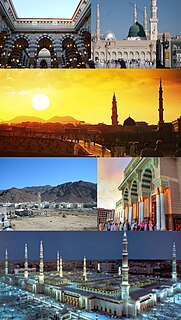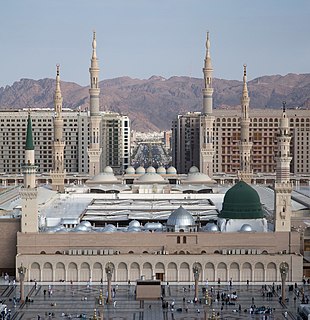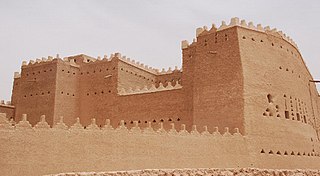
Mecca, officially Makkah al-Mukarramah and commonly shortened to Makkah is a city and administrative center of the Mecca Province of Saudi Arabia, and the holiest city in Islam. It is 70 km (43 mi) inland from Jeddah on the Red Sea, in a narrow valley 277 m (909 ft) above sea level. Its last recorded population was 1,578,722 in 2015. Its estimated metro population in 2020 is 2.042 million, making it the third-most populated city in Saudi Arabia after Riyadh and Jeddah. Pilgrims more than triple this number every year during the Ḥajj pilgrimage, observed in the twelfth Hijri month of Dhūl-Ḥijjah.

Medina, officially Al Madinah Al Munawwarah and also commonly simplified as Madīnah or Madinah, is the second-holiest city in Islam, and the capital of the Medina Province of Saudi Arabia. As of 2020, the estimated population of the city is 1,488,782, making it the fourth-most populous city in the country. Located at the core of the Medina Province in the western reaches of the country, the city is distributed over 589 km2 (227 sq mi), of which 293 km2 (113 sq mi) constitutes the city's urban area, while the rest is occupied by the Hejaz Mountains, empty valleys, agricultural spaces and older dormant volcanoes.

The Arabian Peninsula, or Arabia, is a peninsula of Western Asia, situated northeast of Africa on the Arabian Plate. At 3,237,500 km2 (1,250,000 sq mi), the Arabian Peninsula is the largest peninsula in the world.

Najd, or the Nejd, forms the geographic center of Saudi Arabia, accounting for about a third of the country's modern population and, since the Emirate of Diriyah, acting as the base for all unification campaigns by the House of Saud to bring Arabia under a single polity and under the Salafi jurisprudence.

The Hejaz is a region in the west of Saudi Arabia. It includes the cities of Mecca, Medina, Jeddah, Tabuk, Yanbu and Taif. It is also known as the "Western Province" in Saudi Arabia. It is bordered in the west by the Red Sea, in the north by Jordan, in the east by the Najd, and in the south by the 'Asir Region. Its largest city is Jeddah, with Mecca and Medina being the fourth and fifth largest cities respectively in the country. The Hejaz is the most cosmopolitan region in the Arabian Peninsula.

Taif is a city and governorate in the Makkan Region of Saudi Arabia. Located at an elevation of 1,879 m (6,165 ft) in the slopes of the Hijaz Mountains, which themselves are part of the Sarat Mountains, the city has a 2020 estimated population of 688,693 people, making it the 6th most populous city in the kingdom.

Saudi Arabia, officially the Kingdom of Saudi Arabia (KSA), is a country on the Arabian Peninsula in Western Asia. It has a land area of about 2,150,000 km2 (830,000 sq mi), making it the fifth-largest country in Asia, the second-largest in the Arab world, and the largest in Western Asia. It is bordered by the Red Sea to the west; Jordan, Iraq, and Kuwait to the north; the Persian Gulf, Qatar and the United Arab Emirates to the east; Oman to the southeast; and Yemen to the south. Bahrain is an island country off the east coast. The Gulf of Aqaba in the northwest separates Saudi Arabia from Egypt. Saudi Arabia is the only country with a coastline along both the Red Sea and the Persian Gulf, and most of its terrain consists of arid desert, lowland, steppe, and mountains. Its capital and largest city is Riyadh. The country is home to Mecca and Medina, the two holiest cities in Islam.

Al-Masjid an-Nabawi, known in English as the Prophet's Mosque, is a mosque built by the Islamic prophet Muhammad in the city of Medina in the Al Madinah Province of Saudi Arabia. It was the second mosque built by Muhammad in Medina, after Quba Mosque, and is the second largest mosque and second holiest site in Islam, both titles ranking after the Masjid al-Haram in Mecca. The mosque is located at the heart of Medina and is a major pilgrimage site that falls under the purview of the Custodian of the Two Holy Mosques.

Diriyah, formerly romanized as Dereyeh and Dariyya), is a town in Saudi Arabia located on the north-western outskirts of the Saudi capital, Riyadh. Diriyah was the original home of the Saudi royal family, and served as the capital of the Emirate of Diriyah under the first Saudi dynasty from 1727 to 1818. Today, the town is the seat of the Diriyah Governorate, which also includes the villages of Uyayna, Jubayla, and Al-Ammariyyah, among others, and is part of Ar Riyad Province.

The Grand Mosque seizure lasted from 20 November 1979 to 4 December 1979, when extremist militants in Saudi Arabia calling for the overthrow of the House of Saud besieged and took over Masjid al-Haram, the holiest Islamic site, in the city of Mecca. The besieging militia, known as the Ikhwan, declared that the Mahdi had arrived in the form of one of their leaders: Muhammad Abdullah al-Qahtani; the militants called on all Muslims to obey him. In the aftermath of the seizure, the Saudi Arabian Army, supported by France through advisors from the GIGN, fought the Ikhwan for almost two weeks in order to reclaim Masjid al-Haram.

The Sarawat Mountains, also known as the Sarat, is a part of the Hijaz mountains in the western part of the Arabian Peninsula. In a broad sense, it runs parallel to the eastern coast of the Red Sea, and thus encompasses the mountains of Fifa', 'Asir and Taif. In a narrow sense, the Sarawat start in Taif city in Saudi Arabia, and extend to the Gulf of Aden in the south, running along the entire western coast of Yemen, in what used to be North Yemen, and extend eastwards into part of what used to be South Yemen, thus running parallel to the Gulf of Aden.
Muqbil bin Hadi bin Muqbil bin Qa’idah al-Hamdani al-Wadi’i al-Khallali was an Islamic scholar and a major proponent of Quietist Salafism in Yemen. He was the founder of a Madrasa in Dammaj which was known as a centre for Salafi ideology and its multi-national student population. Muqbil was noted for his fierce criticisms of the Egyptian Islamist scholar Sayyid Qutb; and is considered as an important figure by the followers of the Madkhalist movement.

The Hijaz Mountains or "Hejaz Range" is a mountain range located in the Hejazi region of western Saudi Arabia. The range runs north and south along the eastern coast of the Red Sea, and can thus be treated as including the Midian Mountains, and being part of the Sarawat Mountains, broadly speaking.

The destruction of heritage sites associated with early Islam is an ongoing phenomenon that has occurred mainly in the Hejaz region of western Saudi Arabia, particularly around the two holiest cities of Islam, Mecca and Medina. The demolition has focused on mosques, burial sites, homes and historical locations associated with the Islamic prophet Muhammad, his companions, and many of the founding personalities of early Islamic history by the Saudi government. In Saudi Arabia, many of the demolitions have officially been part of the continued expansion of the Masjid al-Haram at Mecca and the Prophet's Mosque in Medina and their auxiliary service facilities in order to accommodate the ever-increasing number of Muslims performing the pilgrimage (hajj).

The Haramain high-speed railway, also known as the Western railway or Mecca–Medina high-speed railway, is a 453-kilometre-long (281 mi) high-speed rail line in Saudi Arabia. It links the Muslim holy cities of Medina and Mecca via King Abdullah Economic City and Jeddah, using 449.2 kilometres (279.1 mi) of main line and a 3.75-kilometre (2.33 mi) branch connection to King Abdulaziz International Airport (KAIA), in Jeddah. The line is designed for a top speed of 300 km/h (190 mph).

The Hajj is an annual Islamic pilgrimage to Mecca, Saudi Arabia, the holiest city for Muslims. Hajj is a mandatory religious duty for Muslims that must be carried out at least once in their lifetime by all adult Muslims who are physically and financially capable of undertaking the journey, and of supporting their family during their absence from home.
The following is a timeline of the history of the city of Medina, Saudi Arabia.
Wadi al-Qura is a wadi north of Medina in Saudi Arabia, mentioned in early Islamic sources. It was located on the main trade road between the Hejaz and Syria. This valley is also called Imam-e-Mubeen Quran (al-Hijar).

Ahmadiyya is a persecuted branch of Islam in Saudi Arabia. Although there are many foreign workers and Saudi citizens belonging to the Ahmadiyya movement in Saudi Arabia, Ahmadis are officially banned from entering the country and from performing the pilgrimage to Mecca and Medina. This has led to criticisms from multiple human rights organizations.

The wildlife of Saudi Arabia is substantial and varied. Saudi Arabia is a very large country forming the bulk of the Arabian Peninsula. It has several geographic regions, each with a diversity of plants and animals adapted to their own particular habitats. The country has several extensive mountain ranges, deserts, highlands, steppes, hills, wadis, volcanic areas, lakes and over 1300 islands. The Saudi Arabian coastline has a combined length of 2640 km and consists of the Gulf of Aqaba and the Red Sea to the west while a shorter eastern coastline can be found along the Persian Gulf.

















